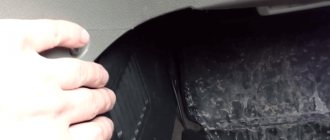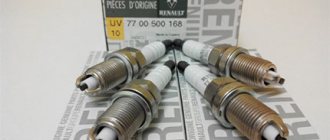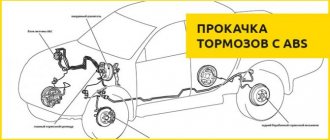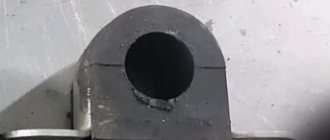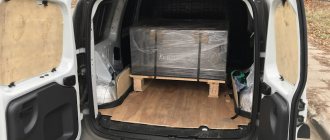Assembly of the Lada Vesta began on September 25, 2015 at the LADA Izhevsk plant. It takes 19 hours to assemble one car from scratch. AVTOVAZ periodically demonstrates to its fans individual stages of the production of this car. At the end of 2021, one of the cheb.media editorial staff visited the plant, who spoke in detail about how LADA Vesta is produced.
Production Lada Vesta
Kolesa.ru visited the production of Lada Vesta.
All Lada Vesta facts are here: https://www.kolesa.ru/article/vse-fakty-o-lada-vesta-2015-02-03 Test drive LADA VESTA. The most voluminous and interesting: https://www.youtube.com/watch?v=zQvwB6X4U7Q
Test drive of Lada Vesta from AVTOVAZ President Bo Andersson: https://www.youtube.com/watch?v=r1NkCPg5GuU
Text test drive Lada Vesta. A huge number of photos and expert opinion: https://www.kolesa.ru/test-drive/pervyj-testdrajv-lada-vesta-2015-09-25 Live report from the start of production of Lada Vesta: https://www.kolesa. ru/news/novaja-lada-vesta_-prjamoj-reportazh-so-starta-serijnogo-proizvodstva-2015-09-24
VAZ build quality
Well, and most importantly, at the very end of the excursion there was practically a ready-made Vesta body that you could look at and touch - it was bare, without sealant, just body panels and a welded body, probably the body was selected and the best one was put up.
The body itself was covered with cataphoresis primer (otherwise the car would simply quickly begin to rust). However, I found a bunch of shortcomings, all of them a consequence of manual assembly, and not by robots, and the quality and geometry of the stamped parts. Let's start in order - the rear panel on the right, its connection to the body looks like this
Everything fits smoothly and tightly, the corners match. Let's look at what's on the right side:
The surfaces do not match, the corners too, it seems that the rear panel is larger in geometry than the body and does not fit into it by at least a few millimeters, some of the welding points are already almost torn off, and upon impact they will simply tear apart very easily.
In addition to the fact that this deprives the car of safety, all the required soil will not get there in the required quantity, it will not be sealed with sealant and the inside will definitely rust intensively, condensation will accumulate, and dirt will definitely fly in from under the bumper.
And this is not just one such place - there are many of them:
In some places, at the corners, apparently so that it doesn’t bulge at all and at least somehow fits, the panel is bent and simply secured by ordinary welding - there the metal will be lowered and will definitely begin to rust, and cavities will contribute to this in every possible way, besides, this is all impossible cover it with sealant, and during operation it still loses its properties, peeling off somewhere, especially with surfaces like these.
And it would be okay just in this place, let’s look at the fit of the roof panel to the load-bearing element, the fit of the pillars to the load-bearing element of the roof:
The threshold in this exhibition body turned out to be crooked, so they cleaned it up like this; I think you can see the door gaps for yourself.
Moreover, it would be good if these were simply unadjusted gaps, but they are simply impossible to adjust - since then the edges of the “X’s” on the doors and wings will not match, and on the one hand it is more or less normal... And so everywhere I go to look...
Nevertheless, even such not the largest and most advanced production is perceived as some kind of miracle - it is here that quite quickly and literally before your eyes, a car grows from a heap of iron. Well, there is a peculiar aesthetics of production - cables, pieces of iron, strange things, all this is accompanied by corresponding sounds and sensations. And the people who are here instead of robots, manipulate the huge paws of spot welding, making noise, crackling and sparks flying around, isn’t this a paradise for a techie?
And the premises themselves are quite vast and the conveyor is quite long, so you will have to walk a long way. And there’s plenty of time to get tired of the noise, impressions and new information, but more on that in the next part, where I’ll talk about how Vestas are painted and all the other components and electronics are assembled directly onto the body.
I also ask you not to make hasty conclusions or conclusions in general based on this article, let’s leave them for the finale!
How Lada Vesta is made.
How Lada Vesta is made.
LADA Vesta is a Russian compact small car that AvtoVAZ has been producing since September 25, 2015. Replaced the LADA Priora family in the automaker's model line. Vesta sales started on November 25, 2015. Video taken from the ALL NEW LADA channel.
Subscribe to the Virtuoso channel - https://www.youtube.com/channel/UCOzEpNaKHDOO_eZTUmXulPw
History of the car plant in Izhevsk
A little about the plant: since 1965, they produced Moskvich, Izh-Oda, VAZ classics, heels, then Kia, which will be discussed in a separate article, because I managed to visit the museum of the enterprise.
After the 2008 crisis, things went really badly - the company laid off employees, there was no work, and bankruptcy took place. In 2010, there was a plan to start producing Koreans again, but there was a sleight of hand and the enterprise was bought by AvtoVAZ, albeit with money from the federal budget (that is, ours), as a result, production was modernized with this money, the production of Grants began, this happened until 2015 year, when the plant refocused on producing Vesta.
At the moment, only Vestas are produced at this plant; 107,000 of them are assembled per year, which is not so little. But, of course, before Soviet times the numbers didn’t even come close. Well, despite the cheerful figures in the statistics - they say the production and sales of West are growing, revenue is growing, the share of Lada is growing, everything is not so simple, the fact is that with revenue growth, production costs are growing much faster (and there will also be a separate article about this ), this is due to the fact that many spare parts are imported, and the ruble, as you know, is falling and falling, in addition, this is due to the huge general inefficiency of the enterprise, a large amount of manual labor.
As a result, for 2021, the losses of Lada Izhevsk almost reached a billion rubles; in 18-19, apparently (no data yet), it will be at the level of one and a half billion. Accounts payable - 8.5 billion, at the end of the year will be at the level of 10 billion, accounts receivable - almost 7 billion rubles. That is, at the moment there are many times more debts than assets. All this data is publicly available in the quarterly reports of both AvtoVAZ and Lada Izhevsk, you can check it.
In principle, in a competitive economy this means only one thing - bankruptcy of the enterprise and its closure. But.. we live in an amazing country, therefore, with the help of injecting our money into the economy of a Japanese-French enterprise (who doesn’t know, AvtoVAZ, which owns the Lada Izhevsk, itself belongs to the Renault-Nissan-Mitsubihsi alliance and is a foreign company that owns in our country there is only an assembly plant) the enterprise exists and in such conditions is trying to develop, which, in principle, turns out: there is growth, but losses are still growing...
LADA Izhevsk Automobile Plant | LADA Izhevsk automobile plant
We are all used to seeing assembled LADA cars on the roads. We are all used to riding them. But how far do our LADAs go before they get to us? Today we will show you the Izhevsk Automobile Plant. This is where the LADA Vesta family cars are assembled, and previously the LADA Granta Liftback model was also produced. Here they go through all the stages. This includes stamping of parts, plastic molding, welding, body and plastic painting, and assembly. Here, cars of the LADA Vesta family undergo tests and all the necessary procedures. This is quite an interesting process. Especially if you drive one of these cars, for example, LADA Vesta. Why not watch LADA work its magic? This is why our team offers you this video.
Assembly
The bodies leaving the painting shop again lose their doors. This was done, firstly, to make assembly easier inside and outside the cabins, and secondly, a separate door assembly area increases work efficiency and reduces the likelihood of defects. The finished doors are returned to the same body from which they were removed.
Conveyor workers place the engine, instrument panel, seats and all the other stuffing on the cars moving around the ring. The process looks fascinating: several people are working on one machine at the same time - here everyone has their own area and their own tasks. An electronic control system has been created in the assembly shop; manipulators and robots help people.
The new car will have to go through five main test posts:
- adjustment of wheel geometry and headlights
- vehicle dynamic test bench
- wheel side slip test setup
- electronic control systems tester
- Leak test chamber.
The vehicle then goes through the AVES quality system. At the exit there is a special area where testers drive new cars back and forth. People's work is interesting and creative.
Ceremonial launch
Interview with Vesta project director Kristina Dubinina
Beginning of Lada Vesta body assembly - photo, video
Moscow, September 11. The Russian automobile manufacturer has released a video showing the process of mass production of the new LADA Vesta SW and Vesta SW Cross models.
Serial production of Vesta SW and Vesta SW Cross cars has begun today. For the serial production of Vesta SW and Vesta SW Cross, the plant launched the production of 79 new parts. In addition, the welding, painting and assembly shops were modernized. Before the start of mass production, Vesta SW and Vesta SW Cross were tested in laboratory and road conditions. According to the company, the new cars will go on sale by the end of autumn.
AvtoVAZ conveyor
By the way, almost all the equipment, machines, presses are all imported. As you know, our country, at the moment, is not capable of producing high-quality machines for such an industry, from domestic ones, from what I saw, only tables, carts, all sorts of small things.
On the one hand, of course, this is sad, because before it was all domestic, but on the other hand, at the moment, this is the only way to ensure at least some acceptable quality of parts, however, in my opinion, the point is not so much in them as in attitude towards work, quality control.
So, for example, the kaizen system was taken from Japanese factories, and so it’s not even a system, but a whole philosophy, it lies in the continuous improvement of production processes, development, auxiliary business processes and management, as well as all aspects of life, respectful attitude towards the client - main postulate. It’s very cool to change not just production processes, but the entire philosophy of both the plant itself and the people working at it. I don’t know how successfully this was implemented at this plant, but it’s a cool thing, Toyota was the first to introduce it, and such borrowing is very commendable.
By the way, for those who are interested in this philosophy and how to apply it in life and business, I highly recommend reading Masaaki Imai’s books “Kaizen: the key to Japanese success.” At the very least, it will be useful for general development, and if you work in an enterprise or have your own business, it will be very relevant!
It’s unlikely that the workers at VAZ read them, but the topic is suitable for personal efficiency and the efficiency of business processes. Nevertheless, brief theses and partial pieces from there are visible at the plant - in the form of slogans, posters, and stands.
In general, the conditions and attitude of the employees, of course, changed and clearly for the better - correct communications, open participation of the same employees, it was easy to come up and ask some questions, they were answered, to the extent possible. I was even able to immediately stumble upon the person I needed, but more on that later.
Many little things make up the production culture, for example, labor protection and human health. The next workshop was the welding shop, and at its entrance, right after the warehouses with body parts, there were boxes and tables with glasses to protect the eyes - really well done. Nothing like this happened last time. And glasses were really needed - the corridor with visitors is located in close proximity to the conveyor itself and sparks and scale from welding fly in all directions, for example, onto the fur coat of a glamorous woman standing next to her, but nothing, they were extinguished))
One of the most important operations for maintaining accuracy, and subsequently the rigidity of the body, is the assembly of the car body itself: these are the side panels, the engine shield, the rear panel, the floor and the roof. Almost everything depends on how this is done.
Add a comment Cancel reply
You must be logged in to post a comment.
AvtoVAZ officially announced the start of mass production of the Lada Vesta SW and Vesta SW Cross models at the plant in Izhevsk.
It is important to note that before the start of mass production of station wagons, more than 100 prototypes of LADA Vesta SW and LADA Vesta SW Cross were tested, which were tested in laboratory and road conditions, successfully passed crash tests and reliability tests with a full load on a special cobblestone road, dirt and gravel tracks. The station wagons underwent cycles of climate research in a thermal chamber at temperatures from minus 40 to plus 55 degrees.


